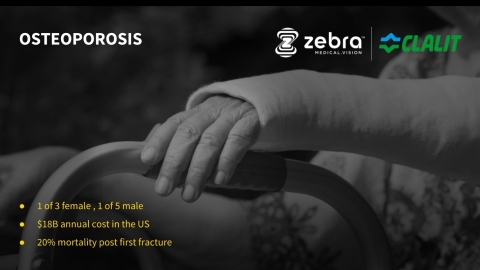SHEFAYIM, Israel--(BUSINESS WIRE)--Zebra Medical Vision (https://www.zebra-med.com) and Clalit Health Services are announcing the completion of a software algorithm which uses existing CT data to identify candidates for bone density screening, allowing earlier identification of patients at higher risk of Osteoporotic fractures. The osteoporosis algorithm was developed in collaboration with the Clalit Research Institute and has received wide interest from various healthcare providers around the world.
Osteoporosis is a disease linked to decreased bone density and a significant increase in the risk of fractures. It is estimated that one of every three women and one in five men over the age of 50 will suffer an osteoporotic fracture during their lifetime. Hip fractures constitute the most problematic outcome of this disease with respect to morbidity and mortality among the elderly, causing lengthier and more costly hospitalization compared to other conditions such as heart attack, diabetes, or lung disease. Less than one third of fracture patients will be able to rehabilitate to their pre-fracture state, while the rest will suffer from loss of mobility and function, affecting the lives of their families as well. In addition to decreased quality of life and an increase in morbidity, the mortality rate as a result of the first fracture is about 20%.
Osteoporosis is a significant burden on the healthcare system, costing nearly $18 billion annually in the US alone. In spite of this, current diagnosis and treatment of the disease is subpar. Compliance with standard bone density screening - called DEXA, is low, and as a result many patients suffering from the disease are not diagnosed or properly treated.
The breakthrough in the algorithmic research of Zebra Medical Vision and Clalit Health Services is in the ability to calculate bone density using CT scans that are performed for other purposes, thus identifying population at risk of osteoporosis, without the need for additional procedures or radiation. These patients can then be referred to preventative care programs, helping reduce fracture rates and the overall burden of the disease.
“Since it is common to find existing CT scans for the relevant age groups inside the provider’s system, it is a more efficient screening process, enabling the identification of patients at risk without additional expenditures and time investment,” says Prof. Ran Balicer, Head of Clalit Research Institute. “Combining the data obtained from this tool together with demographic and medical data at the institute, will enable the efficient prediction of high fracture risk. This is an excellent example of harnessing analytic capabilities and big-data techniques for the advancement of public health.”
“We have been following Zebra’s developments, and are eager to adopt an automatic tool that will enable early detection of people at higher risk for osteoporosis-based fractures,” says Dr. Orit Jacobson, Head of Mor Institute, a leading diagnostic provider. “The algorithm will eventually be used to scan all relevant CT scans in our system, providing an additional layer of diagnosis for physicians, who will be able to reach out to patients with preventative treatment programs. We expect to improve the lives of thousands of patients and their families every year.”
“The strength of our analytics platform is in its ability to find connections between vast amounts of clinical data that has not been cross-examined, and build smart models to improve care,” said Elad Benjamin, Zebra Medical Vision CEO. “With a billion people joining the middle class globally by 2020, and a limited number of physicians and medical students, there is clearly a need to develop tools such as these that will help healthcare tackle this immense challenge.”
About Zebra Medical Vision:
Focused on Deep Learning and Computer Vision Innovation, Zebra Medical Vision uses big healthcare data to deliver an increasing list of insights to the healthcare industry. Current insights are in the fields of Bone, Liver, Lung and Cardiovascular health. Its Imaging Analytics Insights allow health care institutions to identify patients at risk of disease and offer improved, preventative treatment pathways for patient care. Headquartered in Kibbutz Shefayim, Israel, the Company was founded in 2014 by Co-Founders Eyal Toledano, Eyal Gura, and Elad Benjamin and funded by OurCrowd, Marc Benioff, Khosla Ventures, and the Intermountain Healthcare innovation fund. For more information visit www.zebra-med.com. End Users can also access a growing list of the algorithms via http://profound.zebra-med.com/




